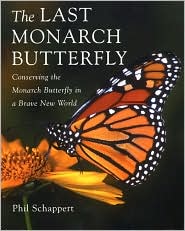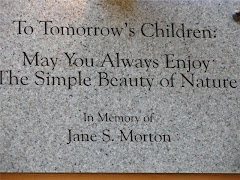 Well, the "Monarch Season" is over, a special season of the year I nicknamed. The last chrysalis to hatch (photo left) was a sad moment for me. As I stared at 60 other empty chrysalis shell casings lining the Monarch rearing cage, I thought about the fun and entertainment having a Monarch Waystation provided me...and my neighbors...throughout the spring and summer. The last Monarch grasped onto the empty chrysalis where it came from, pumped the liquid from its fat body into its wings, pumping them up like a car tire being inflated. I watched in awe. Will it make the 3,000 mile journey to the mountain top in Mexico, whih it is pre-progammed to venture to? Will this fragile creature survive the journey through the Texas corridor, with millions of others, which is plagued by wildfires and drought? I'll never know, since I didn't tag this one. After all, it's special, No. 60...released from my yard in Fremont, Ohio.
Well, the "Monarch Season" is over, a special season of the year I nicknamed. The last chrysalis to hatch (photo left) was a sad moment for me. As I stared at 60 other empty chrysalis shell casings lining the Monarch rearing cage, I thought about the fun and entertainment having a Monarch Waystation provided me...and my neighbors...throughout the spring and summer. The last Monarch grasped onto the empty chrysalis where it came from, pumped the liquid from its fat body into its wings, pumping them up like a car tire being inflated. I watched in awe. Will it make the 3,000 mile journey to the mountain top in Mexico, whih it is pre-progammed to venture to? Will this fragile creature survive the journey through the Texas corridor, with millions of others, which is plagued by wildfires and drought? I'll never know, since I didn't tag this one. After all, it's special, No. 60...released from my yard in Fremont, Ohio.My last Monarch- Waystation #613
Its wings were inflated eventually, but still wet. I watched as they dried out in the slight breeze. I didn't check this one for OE virus or tagged it. Don't disturb it! my mind whispered to me. After an hour, I allowed it to gently crawl upon my finger, then I placed it underneath a yellow Goldenrod flower in the side yard. I saw it nectaring on the yellow flowers. Its wings still hung down to complete the drying. A half hour later, it fluttered away, towards the southwest.
My last Monarch at Waystation#613- released upon a Goldenrod flower
Yes, the end of the Monarch season is upon us. It's marked around Monarch Waystation #613 (My yard) by empty chrysalis shells, wilted milkweed leaves lying on the floor of the Monarch rearing cage, and recollections of the entertainment the Monarchs afforded me... and my neighbors. I've always been fascinated by the orange and black coloration of the Monarch butterfly. Since my childhood days in the Rocky River, Westlake, Bay Village and Avon suburbs of Cleveland. Back then, literally millions of Monarchs would migrate through the vast meadow lands in these suburbs. Now, endless strip malls and pavement replaces the natural landscape I was knew, with a new manscape.
I guess the sections of my grassy yard I turned into wildlife-friendly spaces stemmed from this depressing transformation of natural areas to manscapes. My tiny microcosm of a natural landscape was fun! I collected eggs of the Common and Swamp milkweed planted in my side and backyard, watched them hatch in 3 days, marvel at how the Monarch caterpillars ate the remaining egg shell they came from, observe their tremendous increase in size until transforming into a beautiful Luna-moth green chrysalis with gold dots, then, presto...complete metamorphism into an orange and black beauty. Egg, larva, pupa and adult.
 |
| Click to learn more |
 |
| Click to learn more |
I encourage everyone, even those who don't have a registered Monarch Waystation, to plant in their residential yards butterfly-attracting plants such as milkweed, asters, yarrow, goldenrod, sedum, butterfly bush, lilac, phlox, zinnias, marigolds and petunias...the Monarch butterfly and many other lepidoptera...will thank you.
Robert Morton, M.Ed., Ed.S believes urban sprawl can be offset by creating wildlife-friendly spaces in America's 25,000,000 lawns, one yard at a time! Click HERE to learn why. A portion of Ad sale revenues will be donated to Monarch Watch. Do you have a wildlife-friendly space? Please share it! Contact us on the secure Bpath Mail Form.


